Hot Chips 2020 Live Blog: Intel's Xe GPU Architecture (5:30pm PT)
by Dr. Ian Cutress on August 17, 2020 8:30 PM EST- Posted in
- GPUs
- Intel
- Live Blog
- Xe
- Hot Chips 32
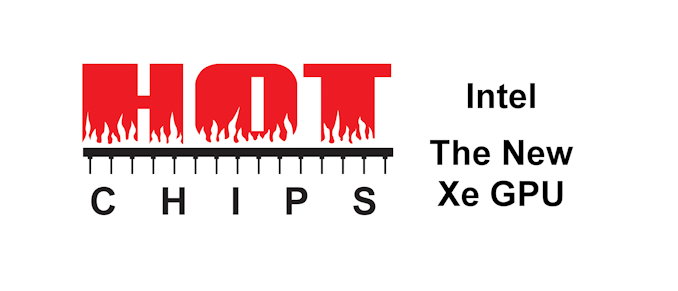
08:37PM EDT - Intel's Xe talk, by David Blythe
08:37PM EDT - David did the Intel Architecture Xe talk
08:38PM EDT - Going forward in architecture than previously covered by integrated GPU
08:38PM EDT - Moving from Gen to Xe -> exascale for everyone
08:38PM EDT - Goals: increase SIMD lanes from 10s to 1000s
08:38PM EDT - Add new capabilities - matrix tensors, ray tracing, virtualization, etc
08:38PM EDT - Also PPA improvements
08:39PM EDT - Required a lot of new design over Gen11
08:39PM EDT - Xe will scale from LP to HPG, HP, HPC
08:39PM EDT - Optimized for different market requirements
08:40PM EDT - Going beyond just adding execution units - but optimizing each segment with individual requirements
08:40PM EDT - Such as ray tracing, media, FP64 etc
08:40PM EDT - LP is integrated and entry
08:40PM EDT - HPG is Mid-range and Enthusiast
08:40PM EDT - HP is Datacenter and AI
08:40PM EDT - HPC is exascale
08:41PM EDT - There is a high-level Xe architecture
08:41PM EDT - 3D/Compute slice, media slice, memory fabric
08:41PM EDT - Each slice has sub-slices
08:41PM EDT - programmable shaders
08:41PM EDT - (Each compute slice is 96 EUs)
08:42PM EDT - Geometry has moved inside the slice and now distributed
08:42PM EDT - Slice size is adjustable
08:42PM EDT - Sub-slice has 16 EUs
08:42PM EDT - Fixed function units (optional based on segment)
08:42PM EDT - 16 EUs = 128 SIMD lanes
08:43PM EDT - hardware blocks for ray tracing
08:43PM EDT - XeHPG that uses Ray Tracing in the lab today
08:43PM EDT - L1 scratch pad
08:43PM EDT - Xe Execution Unit
08:44PM EDT - 8 INT/FP ports, 2 complex math
08:44PM EDT - Media processing can be scaled as well with media slices
08:44PM EDT - de-noise, de-interlace, tone mapping is all here
08:45PM EDT - can distribute a stream across mutiple slices
08:45PM EDT - Xe Memory Fabric
08:45PM EDT - L3 and Rambo cache
08:45PM EDT - Lots of optional stuff here
08:46PM EDT - Allows scaling to 1000 of EUs
08:46PM EDT - Requires multiple dies
08:46PM EDT - Low level tile disaggregation
08:47PM EDT - Mutliple tiles work as separate GPUs or a single GPU
08:47PM EDT - EMIB does XeMF
08:47PM EDT - Xe Link enables XeMF from GPU-to-GPU
08:48PM EDT - XeHP with HBM2e
08:48PM EDT - XeLP is low power optimized
08:48PM EDT - Tiger Lake, SG1, and DG1 will all be XeLP
08:49PM EDT - Tiger Lake goal was to increase perf 2x in graphics
08:49PM EDT - 1.5x larger GPU EUs with scaled assets
08:49PM EDT - 96 EUs, 1536 32-bit ops/clock
08:50PM EDT - Frequency is also 1.5x
08:51PM EDT - Tiger Lake Xe has greater dynamic range
08:51PM EDT - software score boarding per EU
08:52PM EDT - Pairs of EUs run in lockstep due to shared thread control
08:52PM EDT - 2xINT16 and INT32 rates, fast INT8 dot-product that accumulates into one INT32 result
08:52PM EDT - Each subslice has one L1, and up to 16 MB L3
08:54PM EDT - AV1 support
08:54PM EDT - XeHP parts in the lab
08:55PM EDT - XeHP up to 4 tiles
08:55PM EDT - 1 tile can to 10.6 GFLOP FP32
08:56PM EDT - 2 tile can to 21161 GFLOP FP32
08:56PM EDT - 4-tile can do ~42k GFLOP FP32
08:56PM EDT - Shows XeHP can scale
08:57PM EDT - Xe will spread across different nodes and manufacturing
08:58PM EDT - Q&A time
08:58PM EDT - Q: Xe Matrix via AMX? A: There will be an API, disclosed later
08:58PM EDT - Q: Open source driver code? A: Yes, for integrated and discrete
08:59PM EDT - Q: Why 1 RT unit per 16 EUs A: That seemed like the proper scalability. RT throughput can be modulated too - it isn't just a fixed size thing. No details at this time.
09:00PM EDT - Q: Tile-to-tile vs Xe Link ? A: Tile-to-tile is internal protocol in XeMF, but XeLink exposes the protocol, no details but lightweight
09:00PM EDT - Q: CXL? A: There's an intent to support, still working out the details
09:01PM EDT - Q: CPU to GPU comms? A: For XeHPC there is an intent to support CXL
09:02PM EDT - Q: Why are 3D fixed functions optional? A: Not all areas need 3D, like XeHPC. Can turn them off at design time if needed. GPUs can't always carry baggage in specified products
09:03PM EDT - Q: Threads in an EU? A: Not changed much. 1 or 2, in TGL supports 7, little higher in the others
09:04PM EDT - Q: API for ray tracing? A: The standard ones. Khronos, MS. For the high-end rendering, there will be OneAPI for more production type rendering. More details later, similar to embree on CPU
09:04PM EDT - That's a wrap. Next up is Xbox


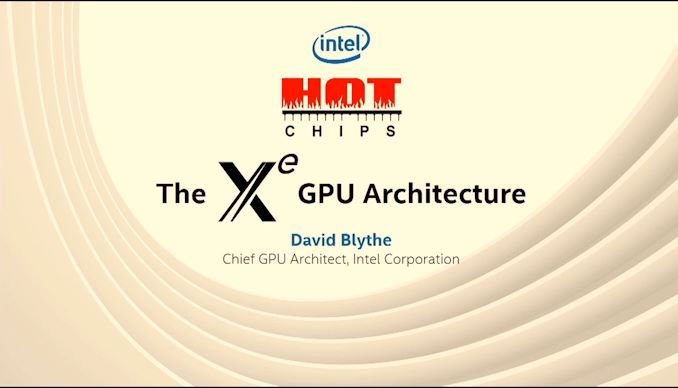

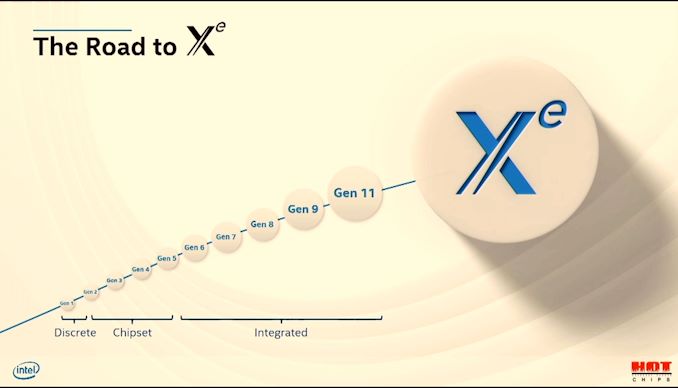
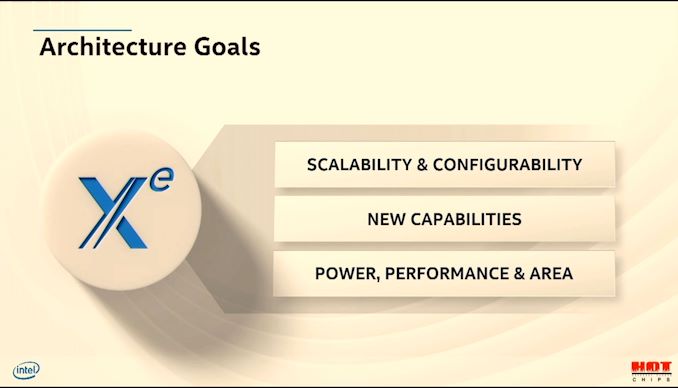
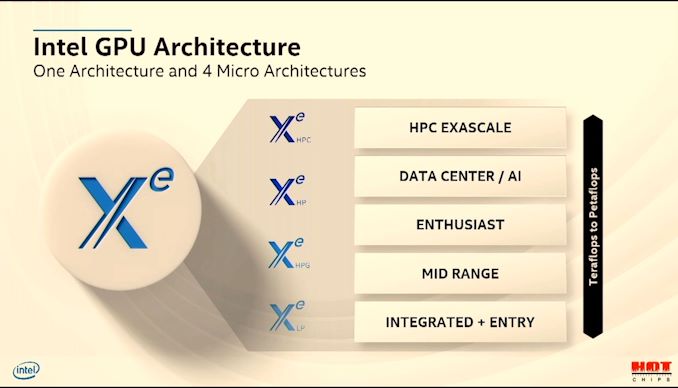

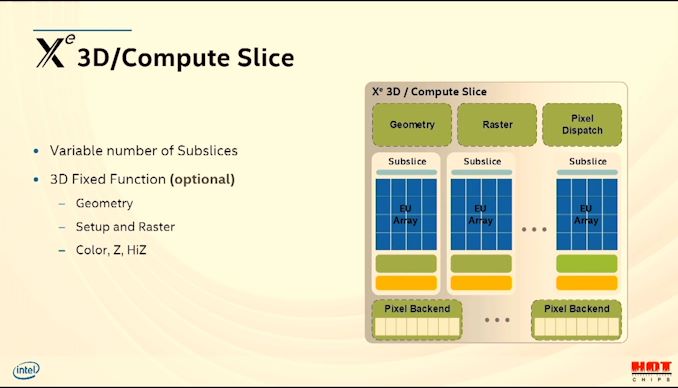
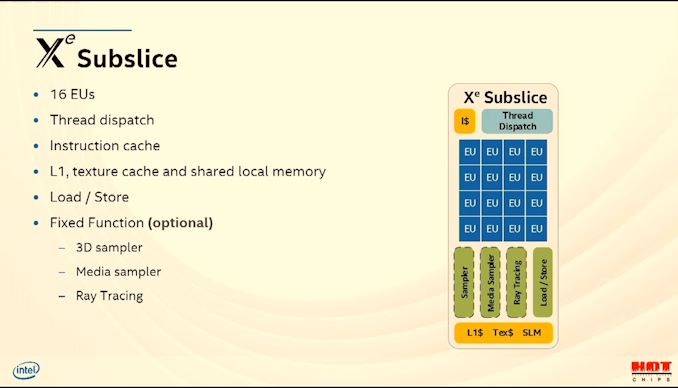
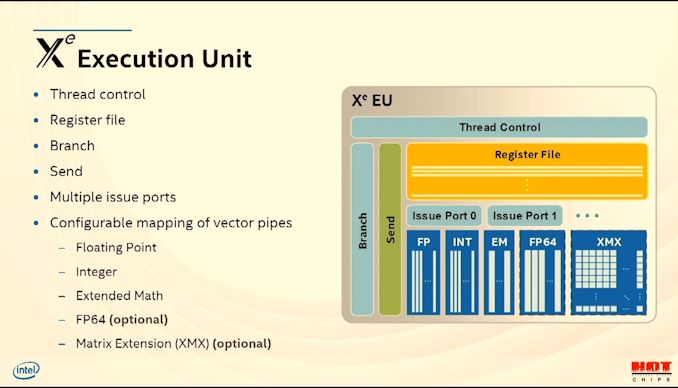

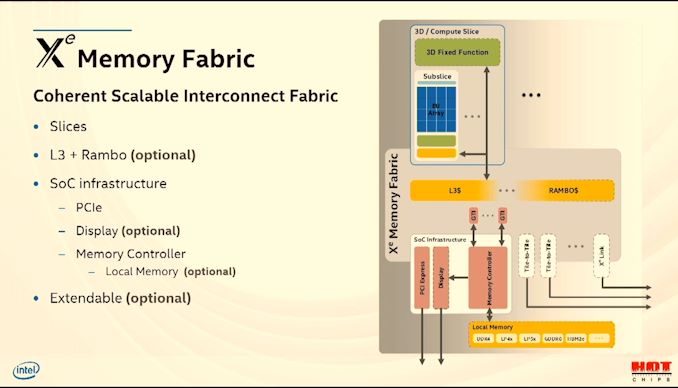
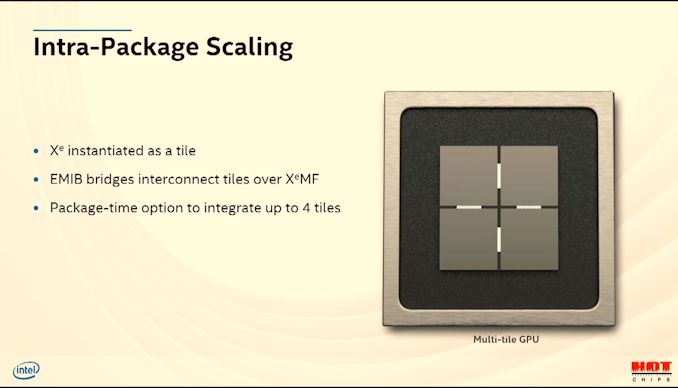
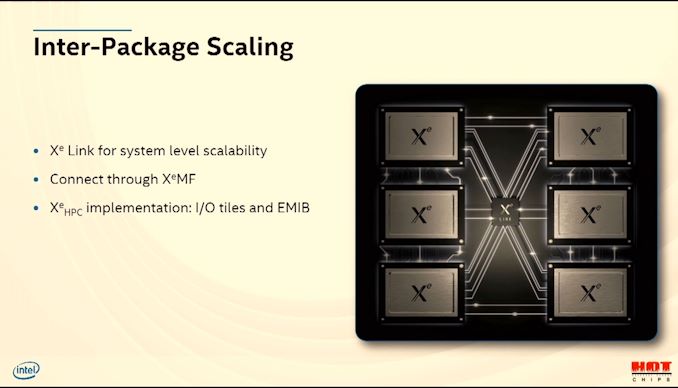
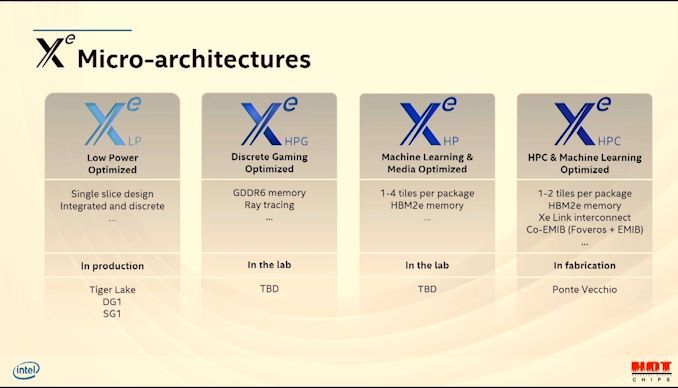

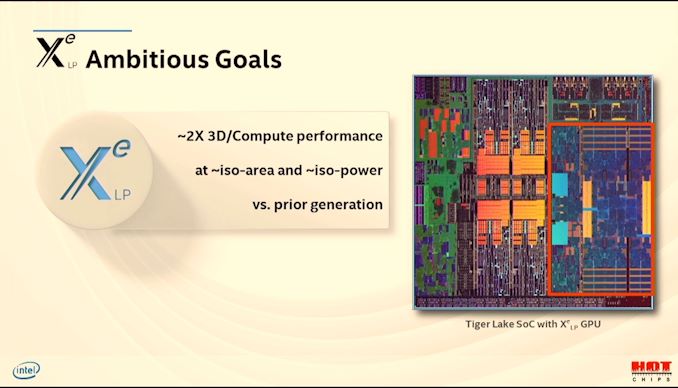

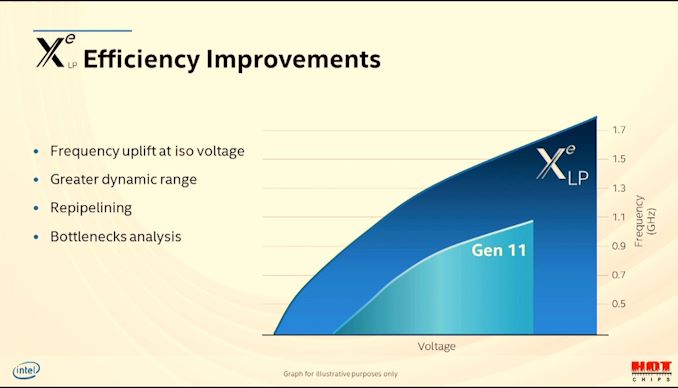
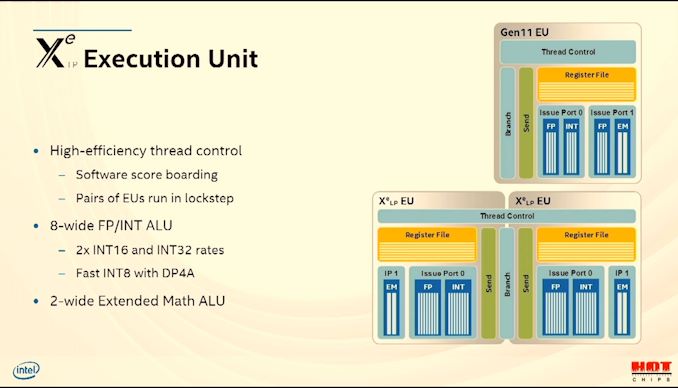
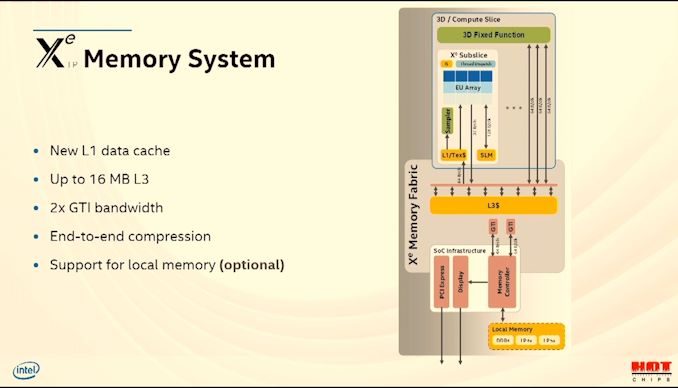
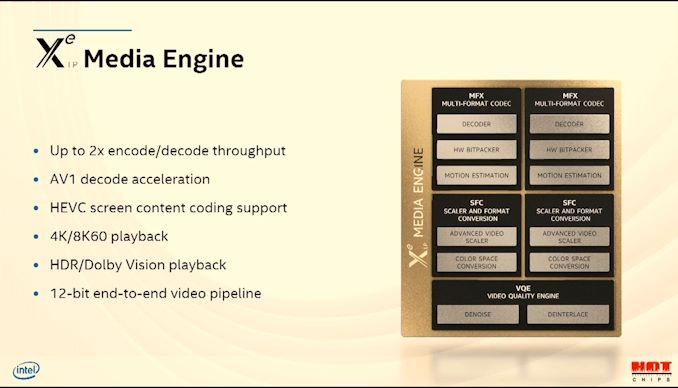

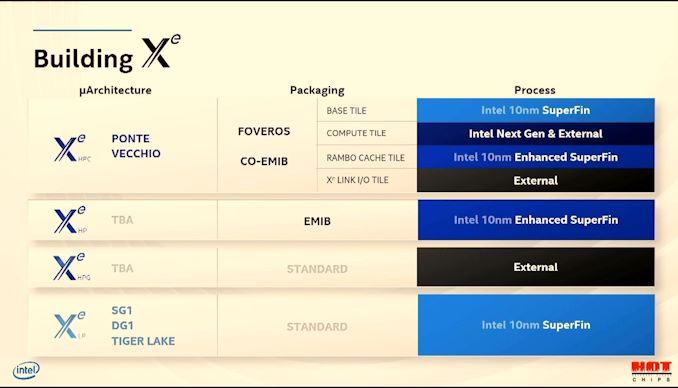
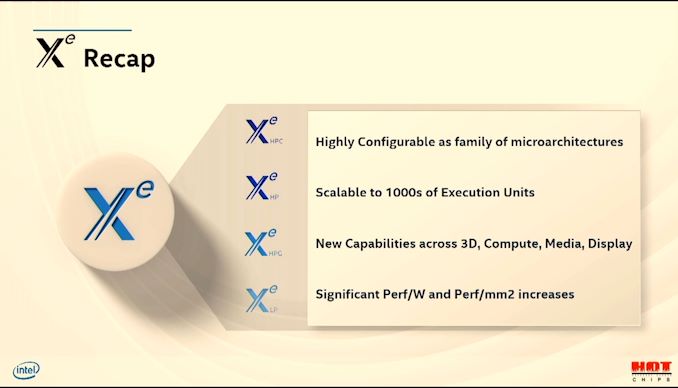









28 Comments
View All Comments
RedOnlyFan - Tuesday, August 18, 2020 - link
Can we expect RT in tiger lake Xe LP or DG1?Question to Ian is the 16MiB L3 cache including 12MiB from core cache?
If it's exclusive to GPU that would be crazy.
yeeeeman - Tuesday, August 18, 2020 - link
There is no point in supporting RT on lower end cards...Cooe - Tuesday, August 18, 2020 - link
No. There is no RT on ANY Xe LP product.Cooe - Tuesday, August 18, 2020 - link
So much die space required for marginally better performance than AMD's absolutely freaking MINISCULE Vega 8 7nm iGPU block... What a disappointment... Are we REALLY supposed to be impressed that they finally caught up to AMD's years old GPU IP while needing 2-3x the die space to get there?edzieba - Tuesday, August 18, 2020 - link
I make out the die to be ~30% GPU in that on-slide die-shot. Tiger Lake is 146mm^2, so the GPU is ~44mm^2.Using the Wikichip dieshot for Raven Ridge, the GPU occupies also 30% of the 210mm^2 die, or ~63mm^2
So, in summary: No.
Fulljack - Tuesday, August 18, 2020 - link
comparing Tiger Lake to Raven Ridge doesn't even make the slightest sense, should've compare it to Renoir, it's direct competitor.Renoir die size are measured around 156 mm², which the GPU take a small size, but I couldn't get the information on how big the GPU block is. you could check it here https://i.imgur.com/fxRNWcM.jpg
Spunjji - Friday, August 21, 2020 - link
I measured it at around 16% of the die (that particular shot seems to leave out a lot of the GPU in its markup, suggesting it's only ~9%, which is silly) - that works out at ~25mm².As a quick sanity check, based on AMD's own statement about "-61% area" from Raven Ridge to Renoir, if we go with edzieba's estimate of around 63mm² for the 11CU 14nm GPU then we get a result of 24.57mm² for the 7nm 8CU GPU - so it seems in the right ballpark.
Ice Lake G7 averages about 66% of Renoir + Vega 8's performance in real titles. If Intel's prediction of a 2x performance increase from Ice Lake G11 to Tiger Lake Xe is borne out, then they'll have a 33% performance advantage over Renoir at the cost of 55% greater GPU die area.
I'm confident in assuming that the numbers Intel are giving out are based on an LPDDR5 design too (why wouldn't they be?), so they're also factoring in a bandwidth advantage to get that result. It's not dismal by any means, but it's not especially thrilling.
Cooe - Tuesday, August 18, 2020 - link
We're talking about Renoir dumbass, not Raven Ridge. They shrunk their iGPU MASSIVELY for Renoir (not just be cutting the CU count either).Arbie - Wednesday, August 19, 2020 - link
Gratuitous insults don't help the forum.Spunjji - Friday, August 21, 2020 - link
I wouldn't call it gratuitous per se - you have to be either not paying attention at all or deliberately trying to stink up the thread in order to compare completely the wrong things in order to "prove" someone else wrong. Quite personal, though.